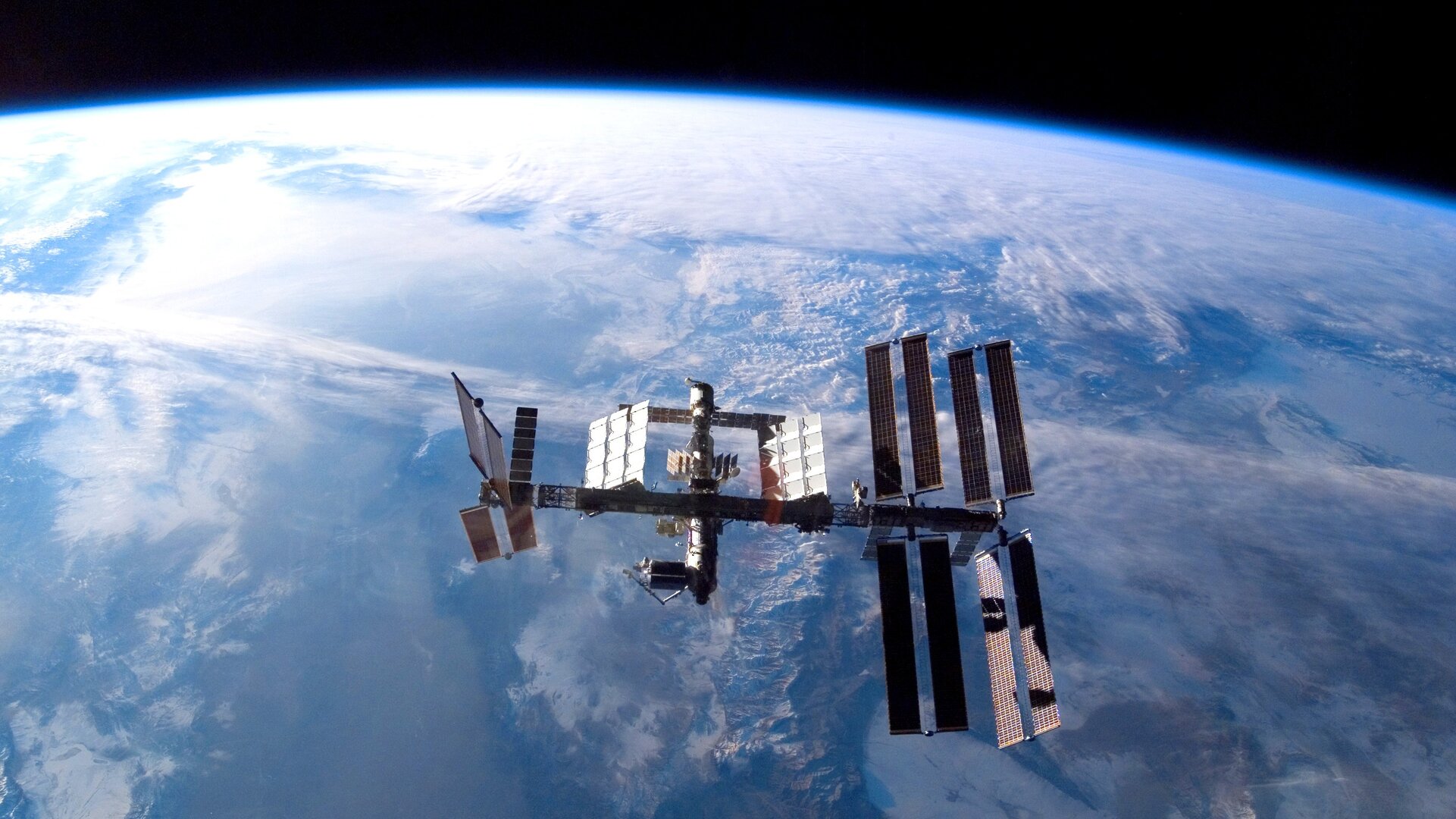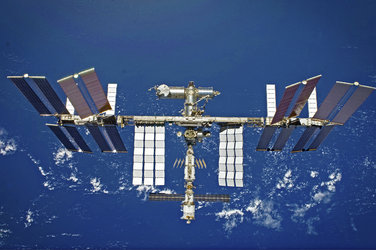International Space Station legal framework
The International Space Station is a co-operative programme between Europe, the United States, Russia, Canada, and Japan for the joint development, operation and utilisation of a permanently inhabited Space Station in low Earth orbit. The legal framework defines the rights and obligations of each of the countries and their jurisdiction and control with respect to their Space Station elements.
The Space Station Agreements
The International Space Station legal framework is built on three levels of international co-operation agreements.
The International Space Station Intergovernmental Agreement, often referred to as 'the IGA', is an international treaty signed on 29 January 1998 by the fifteen governments involved in the Space Station project.* This key government-level document establishes 'a long term international co-operative frame-work on the basis of genuine partnership, for the detailed design, development, operation, and utilisation of a permanently inhabited civil Space Station for peaceful purposes, in accordance with international law' (Article 1);
Four Memoranda of Understandings (MoUs) between the National Aeronautics and Space Administration (NASA) and each co-operating Space Agency: European Space Agency (ESA), Canadian Space Agency (CSA), Russian Federal Space Agency (Roscosmos), and Japan Aerospace Exploration Agency (JAXA).
The objective of these space agencies-level agreements is to describe in details the roles and responsibilities of the agencies in the design, development operation and utilisation of the Station. In addition, the agreements serve to establish the management structure and interfaces necessary to ensure effectively the utilisation of the Station;
- Various bilateral Implementing Arrangements between the space agencies have been established to implement the Memoranda of Understandings. The Arrangements distribute concrete guidelines and tasks among the national agencies
* The Intergovernmental Agreement, establishing the International Space Station cooperative framework, has been signed by fourteen governments: the United States of America, Canada, Japan, the Russian Federation, and 10 Member States of the European Space Agency (Belgium, Denmark, France, Germany, Italy, The Netherlands, Norway, Spain, Sweden and Switzerland; the UK joined in 2012, with Hungary and Luxembourg committing to the Space Station programme in 2019 as well as ESA cooperating state Slovenia).
Who owns the International Space Station?
The Intergovernmental Agreement allows the Space Station Partners States to extend their national jurisdiction in outer space, so the elements they provide (e.g. laboratories) are assimilated to the territories of the Partners States.
The basic rule is that 'each partner shall retain jurisdiction and control over the elements it registers and over personnel in or on the Space Station who are its nationals' (Article 5 of the Intergovernmental Agreement).
This means that the owners of the Space Station - the United States, Russia, the European Partner, Japan and Canada - are legally responsible for the respective elements they provide. The European States are being treated as one homogenous entity, called the European Partner on the Space Station. But any of the European States may extend their respective national laws and regulations to the European elements, equipment and personnel.
This extension of national jurisdiction determines what laws are applicable for activities occurring on a Partner’s Space Station elements (e.g. European law in the European Columbus Laboratory). This legal regime recognises the jurisdiction of the Partner States’s courts and allows the application of national laws in such areas as criminal matters, liability issues, and protection of intellectual property rights. Any conflicts of jurisdiction between the Partners may be resolved through the application of other rules and procedures already developed nationally and internationally.
What is the European share of Space Station’s Utilisation rights?
The rule concerning utilisation of the Space Station provides that each Partner - Europe, United States, Russia, Japan and Canada - may utilise equipment and facilities in or on each other Partner’s elements in accordance with their respective ‘utilisation rights’. Those rights are defined in the Intergovernmental Agreement (Article 9) and the different Memoranda of Understanding, and state that:
- Partners providing International Space Station user elements retain the use of those elements (e.g. research laboratories, such as Columbus);
- Partners providing resources and infrastructure elements to operate and use the International Space Station elements (e.g. Canadian robotic arm) receive in exchange a fixed share of the use of certain elements.
One important point is that ESA and the other Space Station International Partners can barter or sell their unused utilisation rights among themselves and to other non-participants to the Station’s programme.
The common philosophy of this approach is that goods and services are exchanged by space agencies without exchange of funds. The bartering system has enabled a significant reduction of technical and financial risks and has supported the process of standardisation and commonality in the Space Station Programme. The terms and conditions of any barter or sale are determined on a case by case basis by the parties to the transaction, and have to comply with the overall Space Station legal framework.
The European Space Agency allocation rights comprise 8.3% of the Space Station utilisation resources (e.g. communications) and 8.3% of crew time, which represent approximately 13 hours per week. Concerning the user accommodations (e.g. laboratories), ESA has concluded a bartering agreement with NASA, to use 51% of the European Columbus Laboratory in exchange for shuttle transportation services.
Who is liable in case something goes wrong?
The International Space Station legal framework recognises fundamental liability rules concerning space activities, set forth in international space law treaties, such as the Liability Convention (1972), and it goes even further.
The Intergovernmental Agreement establish a 'cross-waiver of liability' which prohibits any of the five Partners or their related entities (contractor, sub-contractor, user, customer) to claim against another Partner (or its related entities) for damage sustained as a result of International Space Station activities (Article 16 of the Intergovernmental Agreement). Each Partner is required to implement this obligation in the contracts with its own contractors and sub-contractors.
Some exceptions to the Space Station cross-waiver of liability exist. For instance, claims arising between a Partner and its own related entities, for example between the European Space Agency and one of its users, will be covered by contracts or sub-contracts that will not implicate the other international Partners.
Other exceptions to the cross-waiver of liability include claims for damages caused by wilful misconduct, claims made by a person for bodily injury or death, and intellectual property claims.
In practice, Space Station users will be asked to agree to an interparty waiver of liability as part of their contract with the European Space Agency, stating that each party will not bring claims in arbitration or sue the other party as a result of International Space Station activities. The applicable law for disputes and the detailed procedures in case of arbitration will be decided mutually by the Space Station users and European Space Agency. The contract will specify the country where the Arbitration Tribunal shall sit, normally in the country where the user has his legal seat.
Protection of intellectual property rights
The main objective of the Space Station Partners concerning property rights is to avoid the infringement of rights owned by another Partner and their entities (e.g. contractors, subcontractors, users).
In order to mitigate the risk of potential infringement, the Space Station Partners have agreed to create specific marking procedures to protect the proprietary and confidentiality of each other’s data and goods. But the Space Station users should be aware that those procedures have to take into account the obligation the Partners have to exchange specific technical data and goods when necessary, to operate and utilise the Space Station in a safe manner (Article 19 of the Intergovernmental Agreement).
Therefore, each space agency and its affiliates - any industry or academic institution under contract - have the obligation to mark their technical data or goods with a notice that indicates any specific conditions regarding how those data or goods may be used by other agencies, their contractors and subcontractors.
The marking rules protect also third-party intellectual property rights. Any third party proprietary data, which may be required in order for the Partners to carry out their responsibilities, or which may be derived from an experiment, will also be properly marked and protected. The specific procedures to protect the Partners’ and their customers’ data and goods are still in the process of being developed by the Space Station Multilateral Co-ordination Board, which comprises representatives of each Partner.
Those procedures cover all personnel, including ground and Space Station crew. The Crew Code of Conduct, agreed on by the Partners in September 2000, sets specific rules and a chain of command for the astronauts and cosmonauts. Some specific regulations concerning the handling of data and goods by the Space Station crewmembers have been included in the Code of Conduct, which contribute to protect the intellectual property rights of Space Station users.
If anyhow an infringement of intellectual property were the cause of a claim for damages, legal proceedings would have to be taken against the infringing party. Those claims would be made according to the parties’ respective national legal regimes for intellectual property. Because of the particular situation of the European Partner and to prevent simultaneous claims in multiple European countries, some specific provisions are provided in the Intergovernmental Agreement (Article 21).
Who owns the intellectual property derived from Space Station utilisation?
As a rule, the industrial and academic users who will have access to the Space Station through the European Space Agency will have their rights and obligations determined by the contractual framework they will have agreed on with the Agency.
The ownership and the exploitation of any intellectual property - data or product - resulting from the Space Station utilisation will then be highly dependent on the type of contract the users will have signed with ESA. But the general Space Station framework sets already the following principles for intellectual property rights.
In the event an invention occurs on the Space Station, the country of inventorship will be determined by the ownership and registry of the Station’s element in which the invention has taken place (Article 21 of the Intergovernmental Agreement). For example, an invention made on a Japanese Element (e.g. Kibo Laboratory) will be deemed to have occurred in Japan.
This does not impact the ownership of the invention, not does it preclude the right to file for a patent in multiple countries. An inventor may file for a patent in any country he chooses. For example a European researcher inventing a process resulting from his experiment in the Kibo Laboratory (Japanese territory), may file for a patent anywhere in the world to protect his invention. The purpose of the territorial approach (e.g. Japanese components of the Station = Japanese territory) is only to determine the location and country where the invention took place.
With respect to the European elements (e.g. Columbus Laboratory), any European Partner State may extend its national law to the European elements and elect to deem the activity to have occurred within its territory. In theory, an invention occurring in the European Laboratory could then be deemed to have occurred in France or Germany. An inventor having used the European Columbus Laboratory facilities may file for a patent anywhere in the world to protect his invention, but he will need to choose one of the European Partner States’ territories to determine where his invention originally took place.















 Germany
Germany
 Austria
Austria
 Belgium
Belgium
 Denmark
Denmark
 Spain
Spain
 Estonia
Estonia
 Finland
Finland
 France
France
 Greece
Greece
 Hungary
Hungary
 Ireland
Ireland
 Italy
Italy
 Luxembourg
Luxembourg
 Norway
Norway
 The Netherlands
The Netherlands
 Poland
Poland
 Portugal
Portugal
 Czechia
Czechia
 Romania
Romania
 United Kingdom
United Kingdom
 Slovenia
Slovenia
 Sweden
Sweden
 Switzerland
Switzerland




























